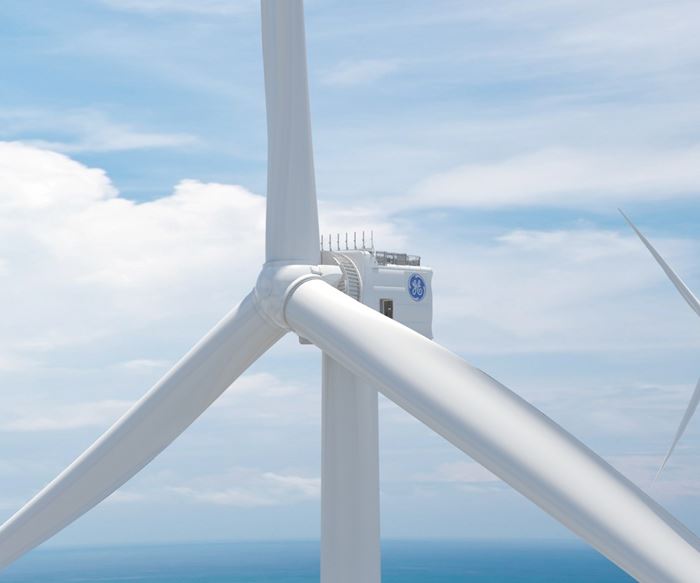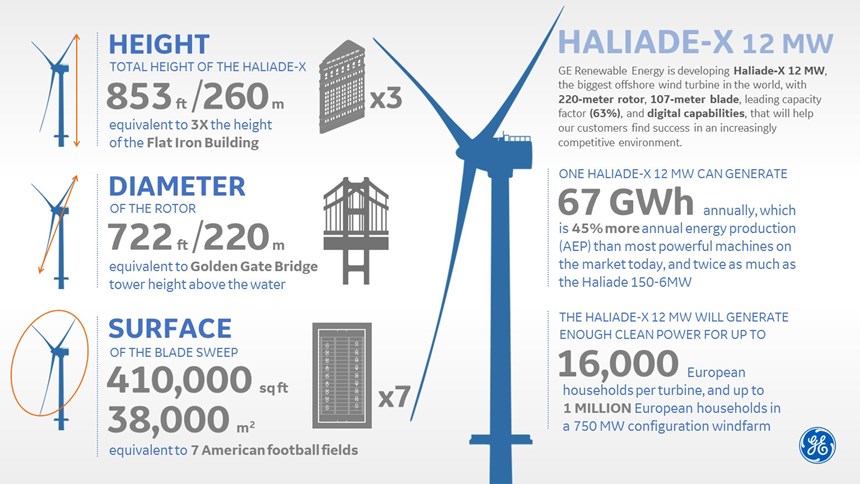GE to develop largest, most powerful wind turbine
The Haliade-X will feature a 12 MW direct drive generator and 107m-long blades.
GE Renewable Energy (Paris, France) unveiled March 1 its plan to develop the largest, most powerful offshore wind turbine: the Haliade-X. Featuring a 12 MW direct drive generator and an industry leading gross capacity factor of 63%1 the Haliade-X will produce 45% more energy than any other offshore turbine available today2. GE will invest more than $400 million over the next three to five years in development and deployment of the Haliade-X.
John Flannery, chairman and CEO of GE, says, "We want to lead in the technologies that are driving the global energy transition. Offshore wind is one of those technologies and we will bring the full resources of GE to make the Haliade-X program successful for our customers."
Towering 260 meters over the sea, more than five times the size of the iconic Arc de Triomphe in Paris, France, the Haliade-X 12 MW carries a 220m rotor. Designed and manufactured by LM Wind Power, the 107m-long blades will be the longest offshore blades to date and will be longer than the size of a soccer field. One Haliade-X 12 MW turbine will generate up to 67 GWh annually2, enough clean power for up to 16,000 households per turbine, and up to 1 million European households in a 750 MW windfarm configuration.
Jérôme Pécresse, president and CEO of GE Renewable Energy says, "The renewables industry took more than 20 years to install the first 17 GW of offshore wind. Today, the industry forecasts that it will install more than 90 GW over the next 12 years. This is being driven by lower cost of electricity from scale and technology. The Haliade-X shows GE's commitment to the offshore wind segment and will set a new benchmark for cost of electricity, thus driving more offshore growth."
The ability to produce more power from a single turbine means a smaller number of turbines in the total farm, which translates to less capital expenditure for the balance of plant and reduced risk in project execution as the installation cycle time is reduced. It also simplifies operation and maintenance of the wind farm. All of this reduces the investment and operation cost for developers, makes offshore wind projects more profitable, and ultimately lowers cost of electricity for consumers.
To design and build the Haliade-X platform, GE Renewable Energy is relying on an unprecedented collaboration across the GE portfolio, leveraging the knowledge of GE's Onshore wind team, with 50,000 turbines in the field; the blade expertise of LM Wind Power; the GE Power and GE Aviation engineers for peer reviews of component and systems design; the Global Research Center for control systems and component validation; and GE Digital for supporting digital modelling, analytics and app development. The program is a GE-wide effort.
GE Renewable Energy aims to supply its first nacelle for demonstration in 2019 and ship the first units in 2021.
1. "Capacity factor" compares how much energy was generated against the maximum that could have been produced at continuous full power operation during a specific period of time.
2. Based on wind conditions on a typical German North Sea site.
Related Content
Drag-based wind turbine design for higher energy capture
Claiming significantly higher power generation capacity than traditional blades, Xenecore aims to scale up its current monocoque, fan-shaped wind blades, made via compression molded carbon fiber/epoxy with I-beam ribs and microsphere structural foam.
Read MorePlant tour: ÉireComposites, Galway, Ireland
An in-house testing business and R&D focus has led to innovative materials use and projects in a range of markets, from civil aerospace to renewable energy to marine.
Read MoreCarbon fiber in pressure vessels for hydrogen
The emerging H2 economy drives tank development for aircraft, ships and gas transport.
Read MoreNovel composite technology replaces welded joints in tubular structures
The Tree Composites TC-joint replaces traditional welding in jacket foundations for offshore wind turbine generator applications, advancing the world’s quest for fast, sustainable energy deployment.
Read MoreRead Next
CW’s 2024 Top Shops survey offers new approach to benchmarking
Respondents that complete the survey by April 30, 2024, have the chance to be recognized as an honoree.
Read MoreFrom the CW Archives: The tale of the thermoplastic cryotank
In 2006, guest columnist Bob Hartunian related the story of his efforts two decades prior, while at McDonnell Douglas, to develop a thermoplastic composite crytank for hydrogen storage. He learned a lot of lessons.
Read MoreComposites end markets: Energy (2024)
Composites are used widely in oil/gas, wind and other renewable energy applications. Despite market challenges, growth potential and innovation for composites continue.
Read More
.png;width=70;height=70;mode=crop)















.jpg;maxWidth=300;quality=90)












